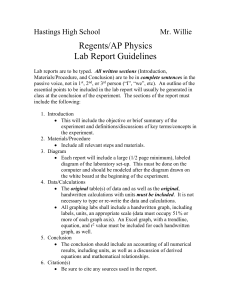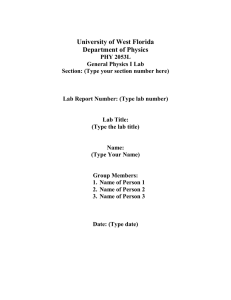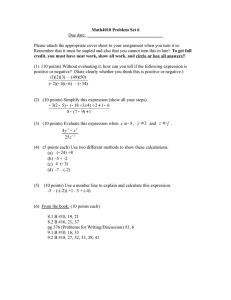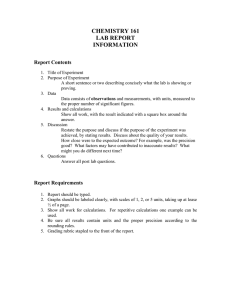Lab Report Writing Guidelines
advertisement
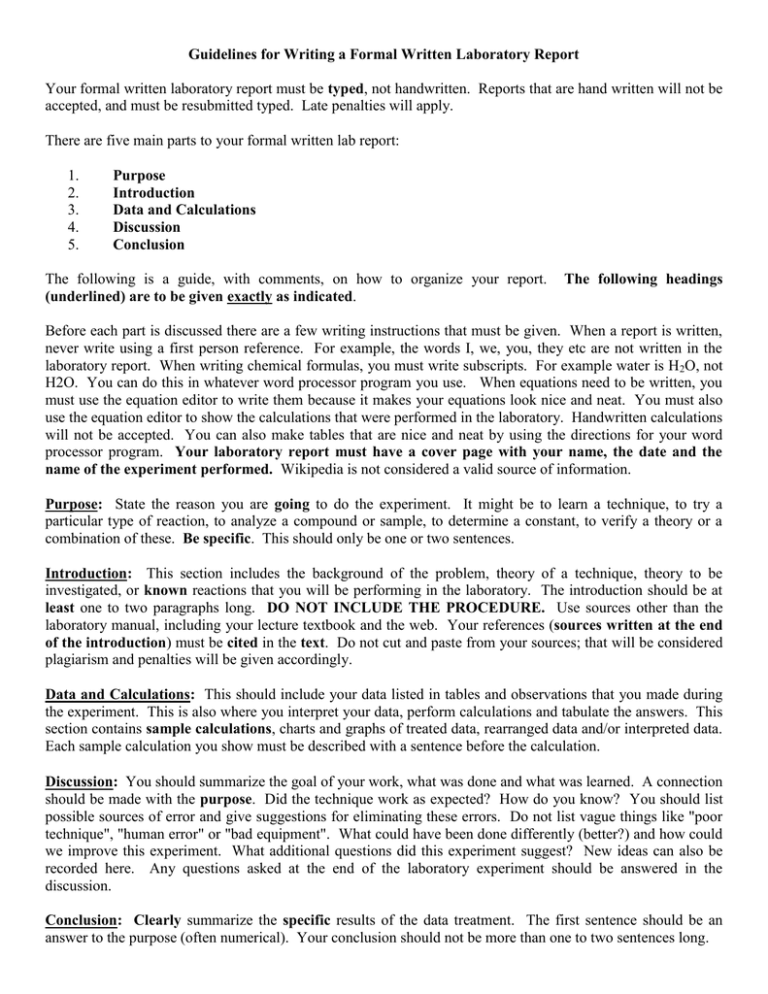
Guidelines for Writing a Formal Written Laboratory Report Your formal written laboratory report must be typed, not handwritten. Reports that are hand written will not be accepted, and must be resubmitted typed. Late penalties will apply. There are five main parts to your formal written lab report: 1. 2. 3. 4. 5. Purpose Introduction Data and Calculations Discussion Conclusion The following is a guide, with comments, on how to organize your report. (underlined) are to be given exactly as indicated. The following headings Before each part is discussed there are a few writing instructions that must be given. When a report is written, never write using a first person reference. For example, the words I, we, you, they etc are not written in the laboratory report. When writing chemical formulas, you must write subscripts. For example water is H 2O, not H2O. You can do this in whatever word processor program you use. When equations need to be written, you must use the equation editor to write them because it makes your equations look nice and neat. You must also use the equation editor to show the calculations that were performed in the laboratory. Handwritten calculations will not be accepted. You can also make tables that are nice and neat by using the directions for your word processor program. Your laboratory report must have a cover page with your name, the date and the name of the experiment performed. Wikipedia is not considered a valid source of information. Purpose: State the reason you are going to do the experiment. It might be to learn a technique, to try a particular type of reaction, to analyze a compound or sample, to determine a constant, to verify a theory or a combination of these. Be specific. This should only be one or two sentences. Introduction: This section includes the background of the problem, theory of a technique, theory to be investigated, or known reactions that you will be performing in the laboratory. The introduction should be at least one to two paragraphs long. DO NOT INCLUDE THE PROCEDURE. Use sources other than the laboratory manual, including your lecture textbook and the web. Your references (sources written at the end of the introduction) must be cited in the text. Do not cut and paste from your sources; that will be considered plagiarism and penalties will be given accordingly. Data and Calculations: This should include your data listed in tables and observations that you made during the experiment. This is also where you interpret your data, perform calculations and tabulate the answers. This section contains sample calculations, charts and graphs of treated data, rearranged data and/or interpreted data. Each sample calculation you show must be described with a sentence before the calculation. Discussion: You should summarize the goal of your work, what was done and what was learned. A connection should be made with the purpose. Did the technique work as expected? How do you know? You should list possible sources of error and give suggestions for eliminating these errors. Do not list vague things like "poor technique", "human error" or "bad equipment". What could have been done differently (better?) and how could we improve this experiment. What additional questions did this experiment suggest? New ideas can also be recorded here. Any questions asked at the end of the laboratory experiment should be answered in the discussion. Conclusion: Clearly summarize the specific results of the data treatment. The first sentence should be an answer to the purpose (often numerical). Your conclusion should not be more than one to two sentences long.
